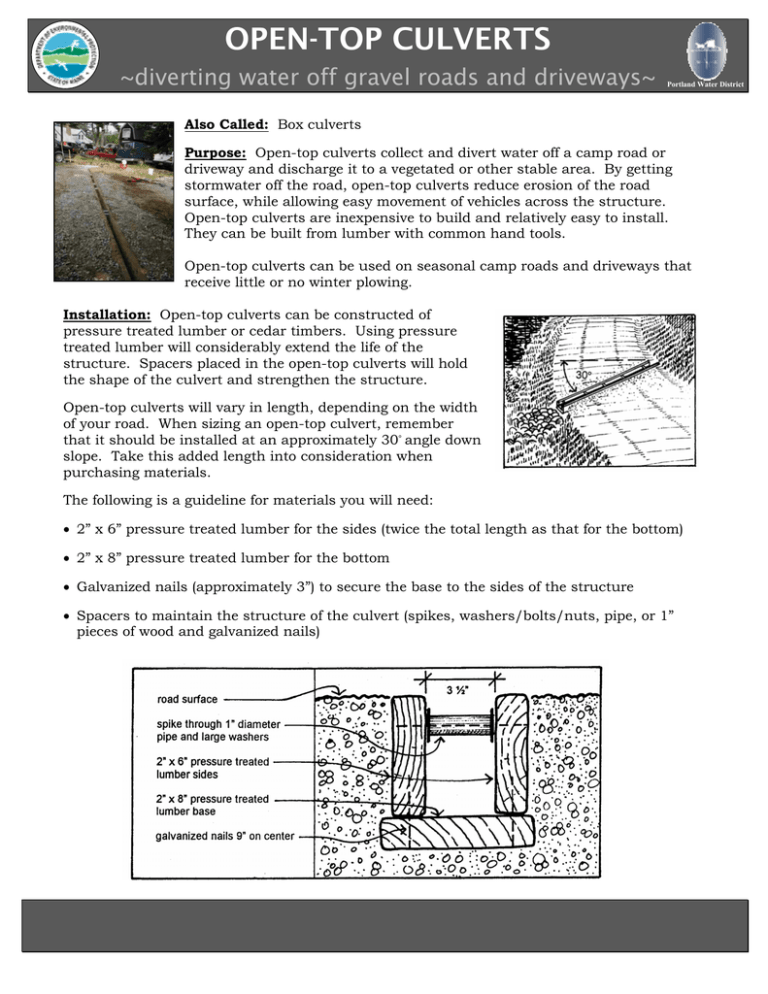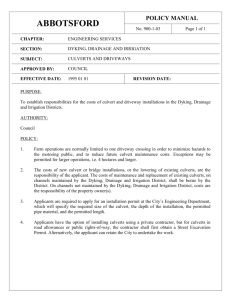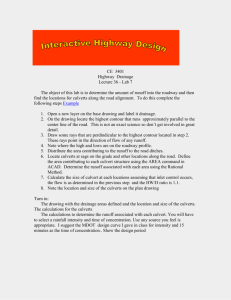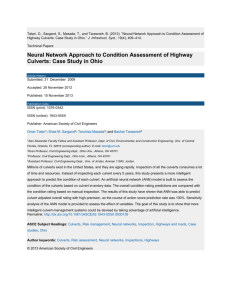OPEN-TOP CULVERTS ~diverting water off gravel roads and driveways~
advertisement

OPEN-TOP CULVERTS ~diverting water off gravel roads and driveways~ Portland Water District Also Called: Box culverts Purpose: Open-top culverts collect and divert water off a camp road or driveway and discharge it to a vegetated or other stable area. By getting stormwater off the road, open-top culverts reduce erosion of the road surface, while allowing easy movement of vehicles across the structure. Open-top culverts are inexpensive to build and relatively easy to install. They can be built from lumber with common hand tools. Open-top culverts can be used on seasonal camp roads and driveways that receive little or no winter plowing. Installation: Open-top culverts can be constructed of pressure treated lumber or cedar timbers. Using pressure treated lumber will considerably extend the life of the structure. Spacers placed in the open-top culverts will hold the shape of the culvert and strengthen the structure. Open-top culverts will vary in length, depending on the width of your road. When sizing an open-top culvert, remember that it should be installed at an approximately 30° angle down slope. Take this added length into consideration when purchasing materials. The following is a guideline for materials you will need: • 2” x 6” pressure treated lumber for the sides (twice the total length as that for the bottom) • 2” x 8” pressure treated lumber for the bottom • Galvanized nails (approximately 3”) to secure the base to the sides of the structure • Spacers to maintain the structure of the culvert (spikes, washers/bolts/nuts, pipe, or 1” pieces of wood and galvanized nails) Install the culvert flush with the surface of the road. If placed too high, stormwater will not enter the structure; if placed too low, it may quickly fill with road material and sediment loosened during installation. The outlet of the open-top culvert should extend beyond the edge of the road. Remove any plowing berms or other debris that could interfere with water flowing from the outlet. Diverted water should flow into a stable area away from the road or open water to allow for infiltration. A stone-lined outlet or vegetated area is an acceptable way of reducing erosion at the culvert outlet. Materials: All materials needed to construct an open-top culvert can be purchased from lumber and hardware stores. Maintenance: Open-top culverts need to be cleaned regularly to remove sediments, gravel, leaves, and twigs. Check after storm events for accumulated sediment. A child’s toy hoe fits easily into the culvert and can be used for cleaning. Open-top culverts are not generally recommended for camp roads that get plowed in the winter. Winter snowplowing can easily destroy this type of culvert and result in even greater erosion problems in the spring. However, some people have had success with open-top culverts if the road is not plowed until the ground is frozen and have an attentive plow driver. If you choose to plow a road with an opentop culvert, you may want to flag both end of the culvert to alert the snow plow drivers. Part of the Conservation Practices for Homeowners Factsheet Series, available at: Maine DEP (800.452.1942); http://www.maine.gov/dep/blwq/docwatershed/materials.htm Portland Water District (207.774.5961); http://www.pwd.org/news/publications.php May 2006 DEPLW0780





